16 October, 2004
Happy Camper School!
*In case you have not seen them, I added a journal entry for October 12, and have put pictures in October 13.*
Yesterday started with learning about how to throw away our trash! Here at McMurdo Station, all waste is removed from the continent by ship. Nothing is buried, burned, or disposed of in any way here. Therefore, they try to recycle as much as possible, and do pretty well - 60 to 65 percent of waste here is recycled. So when you go to throw out your trash, it needs to be sorted into many different categories, including burnables, food waste, biohazard, and recyclables such as glass, aluminum, and plastics, just to name a few.
It's Saturday and Mike and I have returned from a two-day training formally called "Snowcraft I," but known to most people as "Happy Camper School." We are indeed happy campers, after spending the night out on the ice.
Whenever a person or group leaves the station - for example, to go to a field camp, as we will be doing next week - they must take a survival bag. This includes a tent, sleeping bag, thermal pad to sleep on, a camp stove and matches, food, saws, shovels, and a radio. The main purpose of the course is to familiarize people with how this equipment is used.
We started out in a classroom with a lecture by our instructor, Susan Detweiler. We learned about the physiology of keeping warm and getting cold. In Antarctica, it's easy to get in trouble quickly if you're not paying attention to your physical condition at all times.
We went over the three ways that your body makes heat. The first is eating. Warm-blooded animals like mammals (including humans) and birds metabolize ("burn") food to keep a constant body temperature; our bodies are basically like furnaces that require fuel to make heat. For Thompson students - this is why Lurch the python doesn't need to eat every day. He's cold-blooded and his body temperature changes with the environment, so he doesn't need to eat nearly as much as we do. When outside in cold weather, it's important to keep eating to keep body temperature up. This is a great excuse to eat chocolate all day.
The second way to make sure your body makes enough heat is to drink plenty of water. You might think this would cool you off, but if your body doesn't have enough water, the blood vessels in your fingers and toes start to close down (constrict) to make sure that your heart, brain, and other vital organs get enough blood. Therefore, your fingers and toes don't get enough blood and they get cold.
The third way your body makes heat is exercise - most of us have personal experience with this. You jump up and down when you get cold and you get warmer!
The other part of being warm enough is staying warm.
What not to wear at Happy Camper School:
Cotton - if you sweat and it gets wet, you chill down fast.
One big layer, instead of many thinner ones - again, if you sweat in your big red parka, then you get cold. If you have layers, you can take some off when needed so you never sweat.
Clothes that expose lots of skin - Bikinis are frowned upon on the ice.
If you don't pay attention to keeping warm and covered up, you can get hypothermia, in which your body temperature drops below 98.6 F. You can also get frostbite, which usually happens on the face, hands, or feet when the water in the cells in these body parts actually freezes. The ice that forms has sharp edges, and cuts up your cells on the inside. If frostbite is extreme enough, you can lose fingers, toes, even your nose. If you get hypothermia, it is possible eventually to die. Here, this could even happen very quickly.
Armed with our new information, we put on everything that we owned until we looked like red Pillsbury dough boys and climbed into the Delta - a big, orange, retired U.S. Navy vehicle. We drove past the New Zealand research station, Scott, base, and out onto the ice. There, we learned how to light a small camping stove called an MSR stove, and went over to the site where we would spend the night.
Looking up at Mount Erebus, we learned how to make or set up three different shelters: a Scott tent, a mountain tent with a snow wall, and a quinzee.
Scott tents were used by Robert Scott, who was the leader of the second party to walk to the South Pole. He and his team died on the way back from the pole in 1911. The tents are appropriate for Antarctic conditions - they are quite large and you can cook in them safely, unlike mountain tents.
Mountain tents are more like what most people use for camping. They are small, lightweight, and easy to set up. The only problem is that it's very easy for them to blow away unless they are properly anchored. In addition, we sawed blocks out of snow and stacked them up like bricks to make a protective barrier to shield the tents from the wind.
Finally, the most interesting thing we built is a snow shelter called a quinzee. These were originally made by North American native peoples. It's quite of bit of work, but very simple. First, we piled up all our gear bags. Next, we shoveled snow on top of the pile and packed it down hard. When the snow was thick enough that we could push an ice axe up to the end, we knew it was ready. We then had to dig a hole in one side to remove the bags. This left a large room where the bags once were. An entrance was made on the other side, the first hole was filled up, and...home sweet home. Rob, who slept in the quinzee overnight, reported that it was very comfortable.
I slept in one of the mountain tents and I was warm enough. The temperature was -13 F, but it wasn't too cold. One thing I learned is that it's very important to keep your water bottle - and anything else that you don't want to freeze - in your sleeping bag with you!
In the morning, we learned how to use the various types of radios you might take into the field with you. Before you leave the station, you must always check out by radio, saying who you are, where you are going, how many people are in your group, what route you'll take, and what time you will be back. If you are late, a rescue crew will be sent for you very soon, so you need to call in if you are going to be late.
We had a "final exam" in which we had 20 minutes as a group of 12 people to set up a tent and build a small snow wall, boil a liter of water, and contact McMurdo by radio. We passed! Then we did a simulation of "white-out" conditions in which we put white buckets over our heads so we couldn't see and could barely hear, and had to try to find our instructor, who was acting like a person who had gone out into the blizzard and could not find the hut again. It was a very strange feeling, but people who have been in this situation say that the buckets represent it quite well.
No white-outs for us. We had beautiful weather for our Happy Camper School. I know everything we did would be much more difficult if conditions were poor!
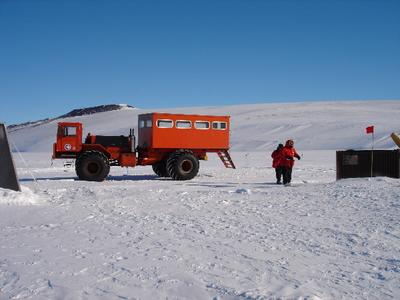
1. The Delta drops us off at our camp.

2. Piling snow over the gear bags.
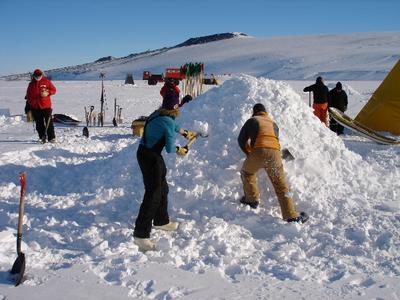
3. Just like winter in Rhode Island!
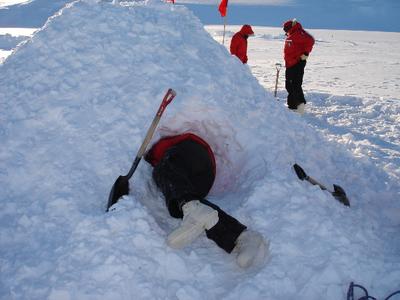
4. Don't worry Mike, we won't let the quinzee swallow you!

5. Our camp, with the yellow Scott tent, quinzee, two small mountain tents, and snow wall.
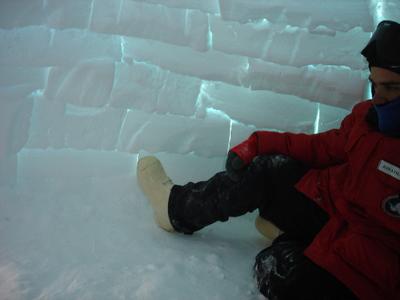
6. Jonathan checks out an igloo built by a previous Happy Camper group. Two people spent the night in this!
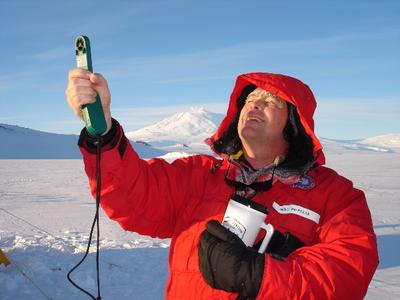
7. Dr. Doug MacAyeal, a glaciologist (scientist who studies glaciers) from the University of Chicago, measures the temperature and wind chill. It was -13F, with a wind chill of -35F.
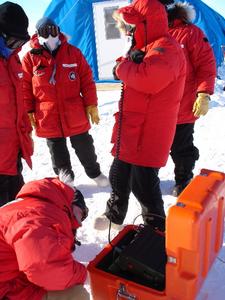
8. "South Pole, this is I-Hut calling for a radio check." We soon found out nobody was on the radio at South Pole Station.
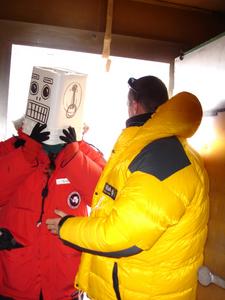
9. The white buckets look funny, but they are used to simulate a very serious situation.
Contact the TEA in the field at
.
If you cannot connect through your browser, copy the
TEA's e-mail address in the "To:" line of
your favorite e-mail package.
|
